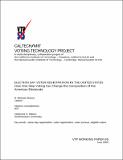Election Day Voter Registration in the United States: How One-step Voting Can Change the Composition of the American Electorate
| dc.contributor.author | Alvarez, R. Michael | |
| dc.contributor.author | Ansolabehere, Stephen | |
| dc.contributor.author | Wilson, Catherine H. | |
| dc.date.accessioned | 2015-04-14T16:29:39Z | |
| dc.date.available | 2015-04-14T16:29:39Z | |
| dc.date.issued | 2002-06 | |
| dc.identifier.uri | http://hdl.handle.net/1721.1/96542 | |
| dc.description.abstract | For most Americans, voting requires two steps. First, an eligible citizen must register in some manner with an appropriate government agency. Second, once registered, the citizen can then cast a ballot on or before election day. The historical record provides examples of voter registration processes as early as 1801 in the state of Massachusetts, followed by Columbia, South Carolina in 1819, the state of Pennsylvania in 1836, and New York City in 1840. After the Civil War, voter registration systems proliferated throughout the nation, especially in large urban areas of the county. By 1929, only Arkansas, Indiana and Texas did not have voter registration systems in place. Today, only North Dakota has no voter registration. | en_US |
| dc.description.sponsorship | Carnegie Corporation of New York; IBM Research | en_US |
| dc.language.iso | en_US | en_US |
| dc.publisher | Caltech/MIT Voting Technology Project | en_US |
| dc.relation.ispartofseries | VTP Working Paper Series;5 | |
| dc.subject | Same-day registration | en_US |
| dc.subject | Voter registration | en_US |
| dc.subject | Voter turnout | en_US |
| dc.subject | Eligible voters | en_US |
| dc.title | Election Day Voter Registration in the United States: How One-step Voting Can Change the Composition of the American Electorate | en_US |
| dc.type | Working Paper | en_US |
